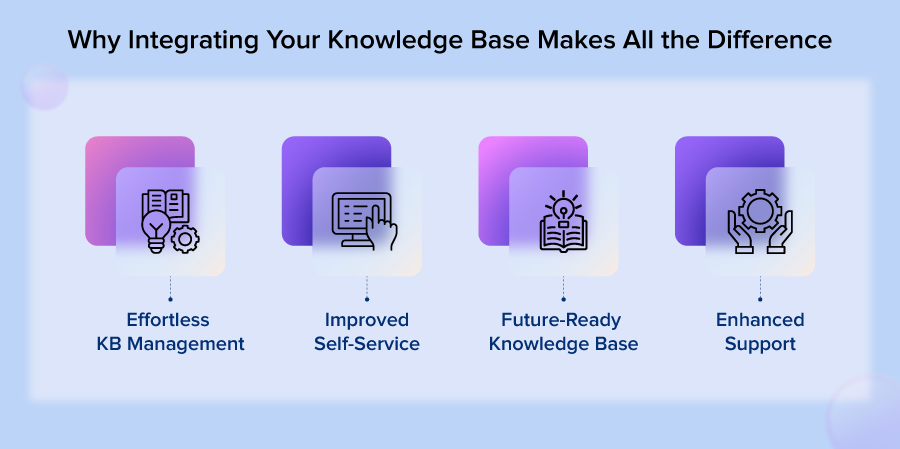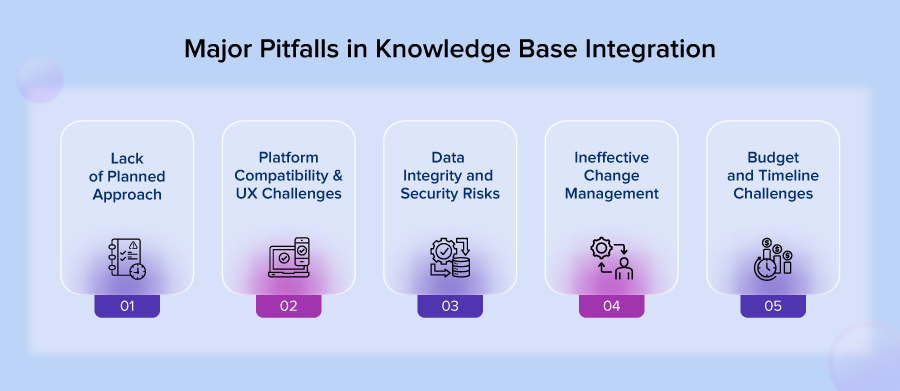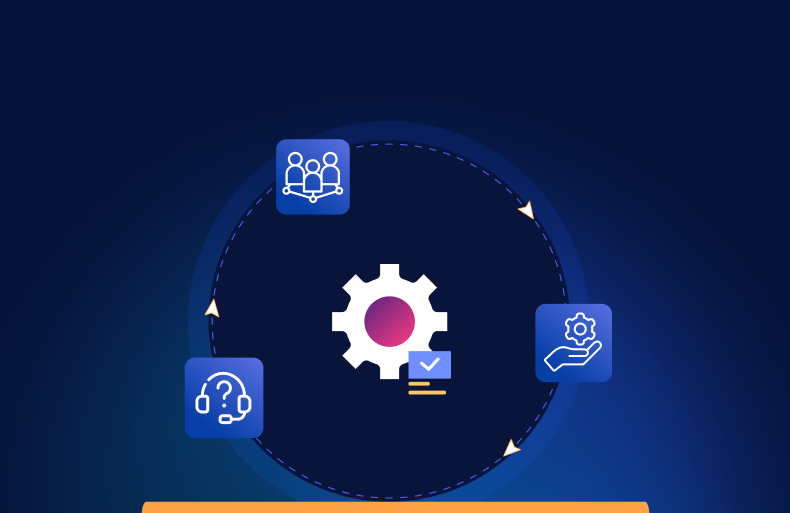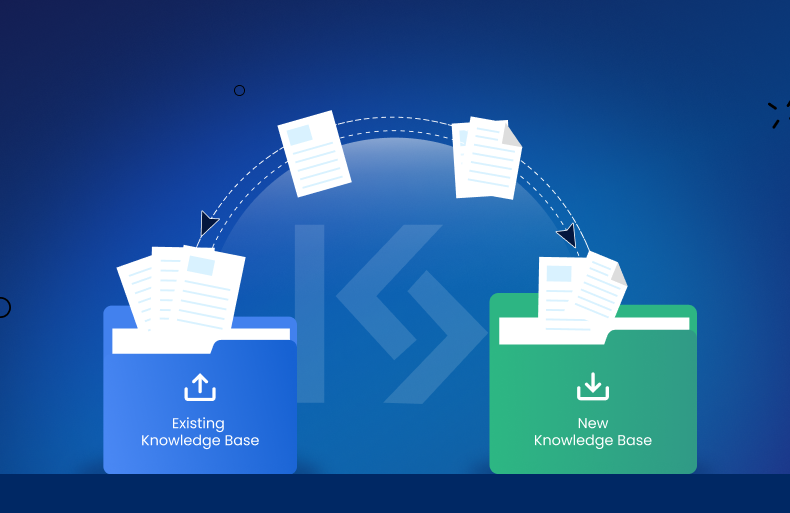5 Key Pitfalls in Knowledge Base Integration: How KaseSync Can Help
A well-maintained and easily accessible knowledge base is the backbone of a successful online community. It offers customers and internal teams access to vital information, such as troubleshooting guides, FAQs, and how-to articles. However, as your community grows, the need to migrate your knowledge base to a more robust platform becomes inevitable.
Whether you want to upgrade to better features, streamline content management, or integrate with a support platform, this change can significantly enhance efficiency and streamline operations.
In this blog post, we’ll dive into the benefits of knowledge base (KB) integration, common pitfalls to watch out for, and a solution to resolve these challenges while ensuring a smooth transition.
Why Integrating Your Knowledge Base Makes All the Difference
Integrating your knowledge base (KB) into a new platform can provide many benefits. Here’s a look at a few of them:

Effortless Knowledge Base Management
By harnessing the power of a modern platform, businesses can easily organize, update, and maintain the knowledge base. Migration from legacy systems is streamlined, reducing reliance on manual processes and ensuring that content remains current, accessible, and well-organized.
Improved Self-Service
An intuitive and accessible platform with a comprehensive knowledge base enables users to quickly find answers. This leads to faster resolutions and empowers users to resolve issues independently, thereby reducing the volume of support tickets and enhancing self-service.
Enhanced Support
An integrated knowledge base centralizes accurate, up-to-date information, helping support agents quickly address customer inquiries. This reduces troubleshooting time, ensures response consistency, and improves overall customer satisfaction.
Future-Ready Knowledge Base
Integrating with a flexible, scalable platform ensures your knowledge base can grow and evolve with changing technology and user needs. This adaptability allows for easy updates, new features, and ongoing relevance, making your knowledge base a long-term asset.
That said, while the benefits of knowledge base integration are evident, it’s also important to be mindful of the challenges that can arise during this change.
Major Pitfalls in Knowledge Base Integration (And How to Avoid Them)
Migrating or integrating a knowledge base can be a transformative process, but there are several common pitfalls that, if not properly addressed, could lead to complications. Here are some of the key risks to watch out for:

Lack of Planned Approach
A common mistake in knowledge base integration or migration is diving in without a clear, strategic plan. Without it, organizations risk delays, content gaps, and disrupted workflows. Conducting a thorough audit of your current knowledge base and planning how it will be integrated is crucial to ensure a smooth transition.
Platform Compatibility & User Experience Challenges
A major challenge during knowledge base integration is ensuring platform compatibility while maintaining a consistent user experience (UX). If the new platform doesn’t seamlessly integrate with your existing system, both customers and internal teams may face challenges. Additionally, if the interface and navigation aren’t intuitive, it can lead to a hampered user experience and decreased engagement.
Data Integrity and Security Risks
Knowledge base integration or migration involves handling large volumes of sensitive data, making data integrity and security critical concerns. Without proper encryption and validation, risks such as data loss, corruption, and misalignment can occur, leading to operational inefficiencies.
Ineffective Change Management
Integrating a knowledge base into a new platform can be a significant adjustment for employees. During this transition, issues like system downtime, broken links, and “404 not found” errors can disrupt daily operations, making it even harder for employees to get accustomed to the new system. Without proper change management, these technical challenges can lead to increased frustration and resistance, further delaying the successful adoption of the new platform.
Budget and Timeline Challenges
Migrating a knowledge base often involves large datasets, custom fields, and sensitive information. Without careful planning, the project may exceed the budget or miss deadlines. For instance, failing to account for content restructuring efforts can result in unexpected complexities that require additional resources to resolve.
To avoid the aforementioned challenges, consider using a solution that ensures seamless integration of your knowledge base.
How KaseSync Solves Knowledge Base Integration Challenges
Integrating a knowledge base doesn’t have to be overwhelming. With KaseSync’s KB Sync, you can reduce the risks and improve the efficiency of the entire process. KB Sync is specifically designed to streamline the knowledge base integration process, ensuring that content is transferred securely, efficiently, and without the typical pitfalls. Here’s how it helps:
- One-Time Migration of Historical Knowledge Base Articles: When switching to a new platform, Kasesync’s KB Sync also helps with the one-time migration of all historical KB articles, ensuring seamless transfer of content and metadata without any loss.
- Bidirectional Synchronization: KaseSync’s KB Sync offers real-time, bidirectional synchronization, ensuring that any new articles or updates are automatically reflected across platforms, keeping your content consistent. Additionally, businesses can choose between bidirectional or unidirectional syncing, based on their needs.
- Mapping and Customization: KB Sync allows for seamless field mapping between platforms, ensuring data is transferred accurately while maintaining consistency in content types, metadata, and other key elements.
- Formatting and Media Sync: KB Sync ensures that both the formatting and media within your knowledge base are fully preserved. From text elements like bullet points, bold text, and indentation to inline images and attachments, everything is transferred seamlessly.
- Synchronization Logs: KB Sync provides detailed synchronization logs to help businesses track the status of their synced articles. If any issues arise during synchronization, the logs offer clear, actionable information, ensuring transparency and enabling quick troubleshooting.
- Retaining the Article State: KaseSync’s KB Sync ensures that not only the content but also the state of your articles is preserved during integration. For instance, if an article is in draft mode on the original platform, it will remain in draft status after transition, maintaining control and consistency in your publishing process.
Wrapping Up
Integrating your knowledge base can be a crucial step toward improving customer experience, streamlining internal processes, and future-proofing your content management strategy. This includes ensuring that your online community remains adaptable and able to scale with changing needs and technologies. However, as with any integration, the process can be riddled with challenges, which, if not carefully managed, can lead to disruptions, data loss, and user dissatisfaction.
With KaseSync’s KB Sync, you can streamline your integration process, ensuring that your knowledge base is successfully transferred with minimal risk and maximum efficiency. By leveraging KB Sync, you will not only ensure a smooth transition but also maintain a consistent, up-to-date knowledge base throughout the process.










